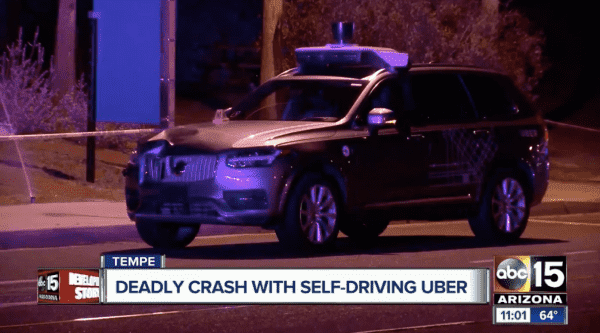
A woman in Tempe, Arizona, has died after being struck by a self-driving car on Sunday in what’s believed to be the first pedestrian fatality caused by an autonomous vehicle on a public road.
The vehicle, operated by Uber, was in self-driving mode, though the car had a safety driver — who in theory could take control of the car in the event of an accident — behind the wheel, according to the Tempe Police Department. The woman, 49-year-old Elaine Herzberg, was crossing the street outside of a crosswalk around 10 pm when she was hit.
Self-driving cars are widely expected to be safer than cars driven by humans, especially as crash avoidance features become more advanced. But it’ll take time to know this for sure, and to develop the regulations that minimize potential harms.
In the meantime, this tragedy will no doubt stoke fears about putting our lives in the hands of car computers. So let’s not forget that getting into, or walking or biking near, a car piloted by a human is one of the most dangerous activities we can do every day.
According to a report released from the Governors Highway Safety Association, there were 5,997 pedestrian fatalities in the US in 2016 — or 16 each day. Globally, road traffic is the fifth leading cause of death in the world.
What’s more, driving a car and being a pedestrian are particularly dangerous undertakings in America, relative to other high-income countries. The US ranks 41st out of 52 high-income countries on road traffic deaths per population, with only a handful of countries — including Qatar, Kuwait, Oman, and Saudi Arabia — trailing behind.
In a recent blog post at JAMA, health policy professor Lawrence Gostin pointed out that the US has been lagging its peers when it comes to implementing evidence-based policies that reduce the risk of traffic deaths. Here’s Gostin:
If the US had kept in step with other countries, David Leonhardt calculated at the New York Times, “about 10,000 fewer Americans each year — or almost 30 every day — would be killed.”
The government could do many things to prevent these accidents — long before self-driving cars become the norm. The US might consider simply lowering speed limits more often and making speed cameras more ubiquitous, Leonhardt suggested. That’s something officials in many other high-income countries have already done.
But it doesn’t have to stop there. According to Laura Bliss at CityLab, “Roughly half of all vehicle occupants killed in crashes over the past five years weren’t wearing seat belts. Yet 16 states still lack primary enforcement seat belt laws for everyone on board.” Some 40 percent of motorcyclists killed on the road were helmet-free, but “more states are repealing helmet requirements than tightening them,” Bliss writes.
So before we freak out about this tragic self-driving car death, we need to keep sight of the bigger picture: At least right now, the non-autonomous vehicles we don’t give a second thought to are the much, much greater public health threat. As we emerge from the “Wild West phase of autonomous vehicles,” regulators should focus not on whether these machines harm people, but on whether they will harm fewer people than human-driven cars.
For now, Uber is investigating the incident and has already suspended its autonomous vehicle operations in Pittsburgh, Tempe, San Francisco, and Toronto. “Our hearts go out to the victim’s family,” the company said in a statement.
Sourse: vox.com






